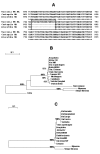Araçatuba virus: a vaccinialike virus associated with infection in humans and cattle
- PMID: 12603984
- PMCID: PMC2901946
- DOI: 10.3201/eid0902.020244
Araçatuba virus: a vaccinialike virus associated with infection in humans and cattle
Abstract
We describe a vaccinialike virus, Araçatuba virus, associated with a cowpoxlike outbreak in a dairy herd and a related case of human infection. Diagnosis was based on virus growth characteristics, electron microscopy, and molecular biology techniques. Molecular characterization of the virus was done by using polymerase chain reaction amplification, cloning, and DNA sequencing of conserved orthopoxvirus genes such as the vaccinia growth factor (VGF), thymidine kinase (TK), and hemagglutinin. We used VGF-homologous and TK gene nucleotide sequences to construct a phylogenetic tree for comparison with other poxviruses. Gene sequences showed 99% homology with vaccinia virus genes and were clustered together with the isolated virus in the phylogenetic tree. Araçatuba virus is very similar to Cantagalo virus, showing the same signature deletion in the gene. Araçatuba virus could be a novel vaccinialike virus or could represent the spread of Cantagalo virus.
Figures



References
-
- Moss B. Poxviridae: the viruses and their replication. In: Fields BN, Knipe DM, Howley PM, editors. Fields virology. 3rd ed. Volume 2. Philadelphia: Lippincott-Raven; 1996. p. 2637–71.
-
- Fenner F, Wittek R, Dumbell KR. The global spread, control, and eradication of smallpox. In: The orthopoxviruses. San Diego (CA): Academic Press; 1989. p. 317–52.
-
- Van Bressem MF, Van Waerebeek K, Reyes JC, Dekegel D, Pastoret PP. Evidence of poxvirus in dusky dolphin (Lagenorhynchus obscurus) and Burmeister's porpoise (Phocoena spinipinnis) from coastal Peru. J Wildl Dis. 1993;29:109–13. - PubMed
Publication types
MeSH terms
Substances
LinkOut - more resources
Full Text Sources
